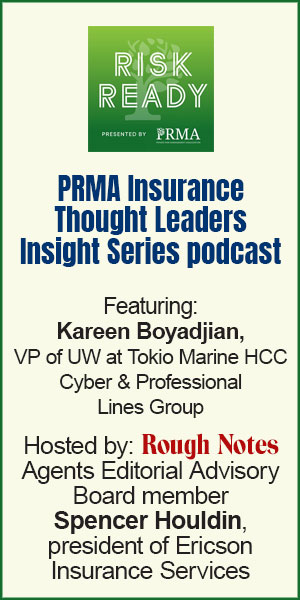 A.I. AND H.I.—COLLABORATORS OR ANTAGONISTS?
A.I. AND H.I.—COLLABORATORS OR ANTAGONISTS?
Creating a future together
We now appear to be
experiencing the golden age of artificial intelligence, with important technology
breakthroughs and massive investments.
By Dr. William T. Hold, CIC, CPCU, CLU
In the great tradition of our country, as we now rush head-long into the era of artificial intelligence, we are fast approaching the “uncharted zone.” This was once the domain of sea monsters, mythical lands, the place where mariners fell off the face of the earth and faced the first phase of extinction.
However, it was a place where various adventurers believed the potential treasures outweighed the potential risks.
In several ways, this is reminiscent of the “dot-com era” of unbridled enthusiasm, exaggerated expectations, and unsupported predictions. The common thread is the continual important and dramatic breakthroughs in technology in almost all fields—all founded in many ways through the power of H.I., human intelligence.
Not surprisingly, artificial intelligence (A.I.) has become a very important subject in the insurance community in areas including underwriting, potential loss development, operations, and marketing. Great attention is being paid to the potential impact of A.I. and technology in general on the agency business.
Before we turn to a discussion of impacts and consequences, it always helps to look at some of the fundamentals.
First, in the most basic terms, A.I. is based on machine learning. It results from applying science techniques to artificially create something that will perform tasks that only humans can do. These include reading, learning, reasoning, remembering, and problem solving. These are examples of what are called our cognitive skills.
Second, A.I. is not new. It began in cycles of development and investment and periods of slower development and lack of funding during the 1950s. These cycles were created by important developments in technology, positive expectations; and then development stalled, followed by lower expectations.
We now appear to be experiencing the golden age of A.I., with important technology breakthroughs and massive investments. In fact, in some quarters, there is a belief that A.I. will become A.G.I.—artificial general intelligence, an intelligence level that equals or exceeds human intelligence.
Insurtech
Given our current knowledge base, there is little doubt that A.I. or A.G.I. in some form and at some future time will significantly impact the risk management and insurance community.
Literally hundreds of millions of dollars are being invested in companies and related ventures that are broadly labeled as insurtech. There are essentially two reasons for all the intense interest, investment, and massive global attention.
The first is one of the two most important words in the English language: money. Risk management and insurance represent global services and products—products and services that impact the success of governments, businesses, and families around the world. It’s a market measured in trillions of dollars.
Second, as various sectors of our economy have been studied and reviewed in terms of the utilization of technology and digitalization, two sectors have been identified as being the slowest adopters. These are the insurance and government sectors. Thus, we have insurtech and the much less publicized govtech.
Govtech has, in essence, focused on making it simpler and easier to communicate and deal with local, county, and state governments. Today, people across the country can pay bills, renew licenses, obtain permits, and perform many other tasks without going to a government office.
In addition, governments have improved outdated or otherwise antiquated legacy systems. Has govtech made dealing with the county or city a day at the beach? Hardly!
The most important point to understand is that govtech has not changed the functions of governments. What has changed is how they perform their functions. Only human action will initiate changes in function and purpose.
Impact
While there are parallels between insurtech and govtech, they are not identical efforts. However, there is one common characteristic. In its current state, insurtech activity has had very little impact on the nature of the risk or the exposure. In short, it does little to alter the fundamental risk being assumed.
It has almost everything to do with information gathering, gaining greater knowledge of the risk, communication with the client/insured, and marketing.
To be clear there are various insurtech activities that impact the risk. Among the best examples are those that monitor the work of commercial vehicle drivers to ensure that safety standards are developed, implemented, and followed. Other systems can gather more complete and current information on a property risk to remove or reduce potential causes of loss.
An often-asked question is why the main body of the insurance industry, i.e., companies, have allowed an environment to exist and grow that breeds and nurtures the insurtech effort? While there are many reasons, they include some of the following.
Large and complex organizations are often slow to react. Changing direction can be problematic and has resulted in very poor outcomes. These companies can have very large legacy technology systems that cannot be quickly or efficiently modified.
In addition, a significant impact of many insurtech processes can in some ways marginalize the traditional roles of agents. The effect of this marginalization on the agent-company, company-insured, and agent-insured relationships remains unknown.
Throughout human history there has been a constant search for a better way. The essential problem is that the better way differs in the eye of the beholder. Is it the fairest, the most efficient, the simplest, the easiest, the one that makes the most money, or the one that is the more honest? And the list goes on?
The central question is—a better way for whom?
There is now an increasing recognition that those who develop and implement A.I. (or in the future, A.G.I.) techniques and processes do not have a free license to create a better way tailored to their interests only. There exists a far deeper and greater global responsibility to develop and implement a better way for the most people possible.
It is not surprising that the focus of reaching this goal is government regulation and oversight on a global scale. If history has any predictive value, we face serious challenges in achieving our collective goals.
The answers to many of the above questions will require a combination of A.I. and H.I. If you believe as many do, including me, that the foundations of intelligence are human in origin, we have a fighting chance.
The author
William T. “Doc” Hold, Ph.D., CIC, CPCU, CLU, is executive chairman of The National Alliance for Insurance Education & Research, which he co-founded in 1969 as The Society of CIC. Under his leadership, The National Alliance has grown to become one of the most prestigious insurance education organizations in the world. In this column Doc shares his personal insights and opinions, which are not necessarily those of The National Alliance or its board members.




